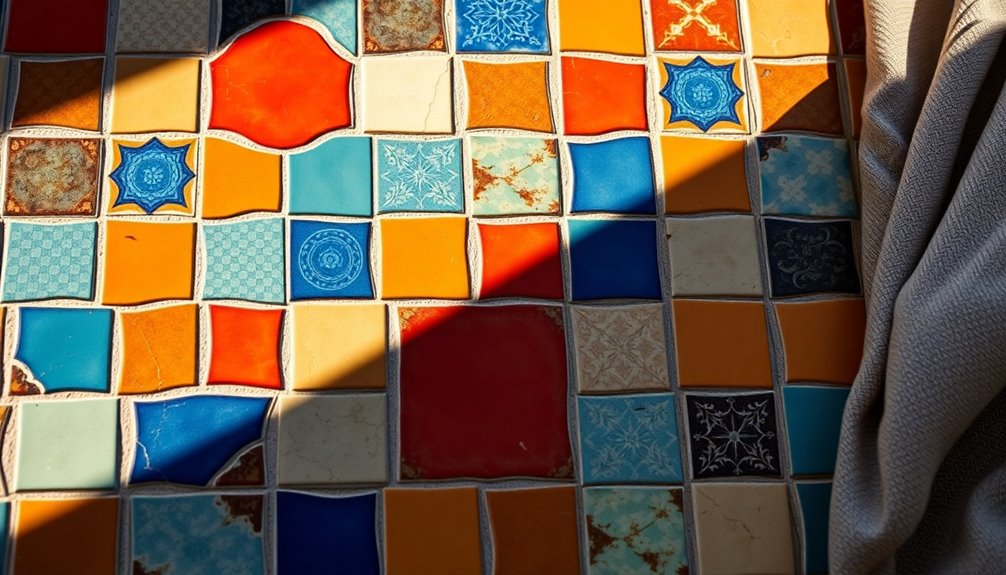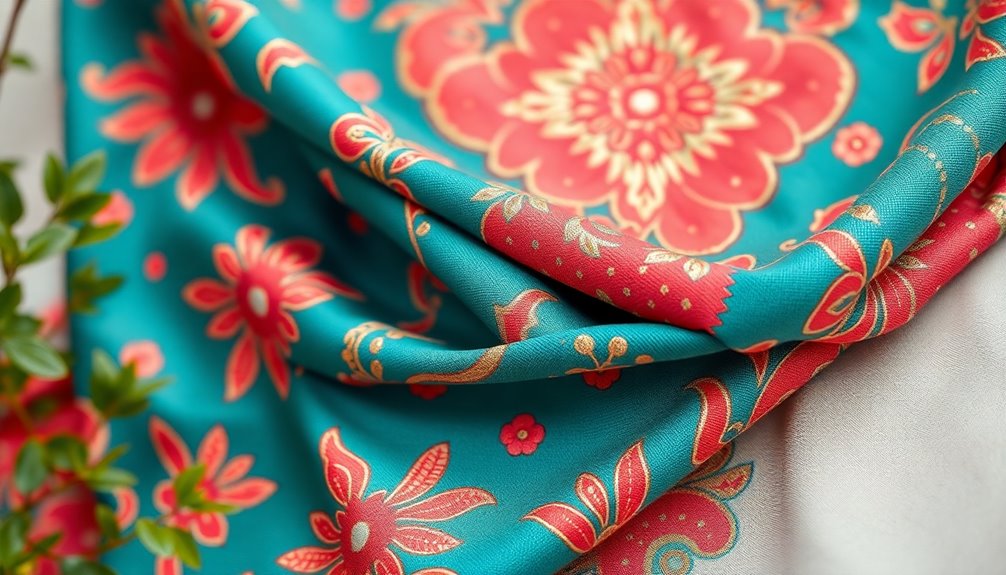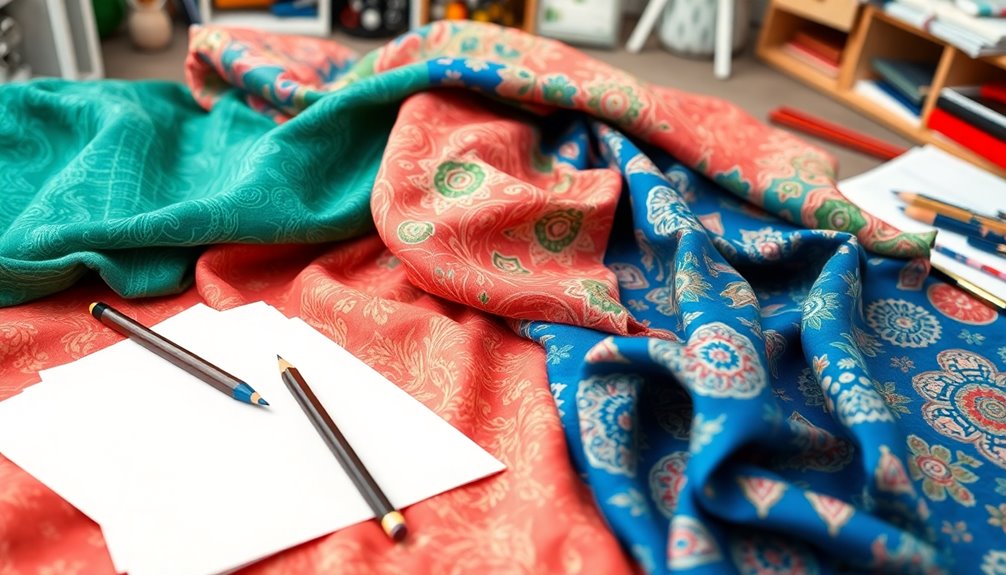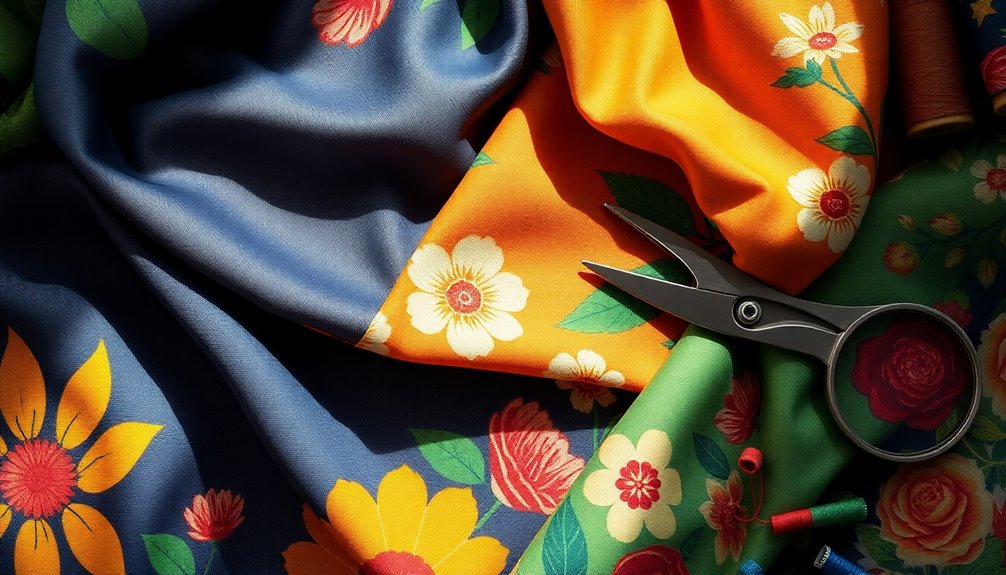To design like a pro, you need to master seamless patterns and intricate tiling techniques. Focus on color harmony to create enchanting designs that resonate with viewers. Pay attention to scale and repetition for added depth and interest. Don't forget to use mock-ups to visualize your patterns on various products. Engaging with the design community can provide valuable insights and inspiration. Stick around to uncover more tips that'll elevate your pattern and textile skills!
Key Takeaways
- Master seamless patterns by ensuring they repeat without visible seams through manual testing and advanced tiling options in design software.
- Experiment with various tiling techniques, such as octagon, arabesque, and honeycomb, to create unique and visually engaging designs.
- Pay attention to scale and repetition, as larger designs make bold statements while smaller motifs offer intricate detail and harmony.
- Utilize color theory to achieve color harmony; mix warm and cool tones for depth and ensure vibrancy through testing combinations in design software.
- Leverage mock-ups to visualize patterns on real-world items, ensuring seamlessness and professional presentation across multiple designs.
Understanding Seamless Patterns

When you plunge into the world of seamless patterns, you'll quickly discover their versatility and appeal. These designs can repeat endlessly without visible seams, making them perfect for digital papers and print-on-demand products.
With tools like Wrapper, you can explore advanced tiling options such as octagon, Arabesque, and honeycomb, allowing you to create unique seamless patterns that stand out. To guarantee your patterns are genuinely seamless, you'll need to manually tile them in design software, adjusting size and DPI for exceptional quality.
Plus, visualizing these patterns on 3D items like cushions and mugs helps you understand how they'll look in real life. Bundling successful seamless patterns into coordinated design packs offers a cohesive aesthetic that enhances your projects.
Exploring Tiling Techniques

As you explore tiling techniques, you'll discover that the right approach can elevate your design work considerably. Wrapper offers advanced options like octagon, Arabesque, and honeycomb shapes, allowing you to create diverse patterns that enhance visual interest. You'll be able to see how adjusting tiling options and manipulating image sections guarantees a coordinated design across multiple patterns.
| Tiling Technique | Description |
|---|---|
| Octagon | Unique geometric shapes |
| Arabesque | Intricate, flowing designs |
| Honeycomb | Hexagonal, versatile layouts |
| Seamless Testing | Check for visible seams |
The Importance of Scale and Repetition

Scale and repetition are essential elements in pattern design that can greatly influence the overall aesthetic and functionality of your work.
The scale of your pattern considerably affects its visual impact; larger designs create bold statements, while smaller motifs offer subtlety and detail.
Repetition is key, as consistent intervals enhance harmony and flow, making your pattern cohesive. By utilizing different scales of repetition, you can add depth and interest, creating a dynamic visual experience.
Always test the seamlessness of your patterns through manual tiling to validate that scale and repetition align effectively, preventing visible seams that disrupt the design.
Understanding this relationship helps you craft versatile patterns suitable for various applications, from textiles to digital media. Moreover, implementing natural materials in your designs can enhance the overall texture and warmth of the space, reflecting the principles of traditional Indonesian style decor.
Color Harmony in Pattern Design

Patterns come alive not just through scale and repetition but also through the thoughtful application of color harmony. Understanding color harmony is vital in pattern design, as it enhances the overall aesthetic and creates compositions that resonate with viewers.
Utilize color theory principles like complementary, analogous, and triadic schemes to choose colors that work seamlessly together. Mixing warm and cool tones can add depth and versatility to your designs, perfect for textiles or digital papers.
To guarantee your color combinations maintain vibrancy and clarity, test them using design software like Affinity Designer.
Don't forget to engage with community resources, such as Facebook groups, to gain valuable feedback on your color choices and refine your skills in achieving effective color harmony.
Utilizing Mock-Ups for Visualization

Utilizing design software like Affinity Designer, you can efficiently present your seamless patterns on items like digital papers, cushions, and scarves.
Make sure to create templates within your mock-ups to maintain consistency across multiple designs, ensuring a professional presentation.
The fast creation process enhances your workflow, allowing you to quickly demonstrate the potential of your patterns in real-world applications.
Additionally, manual testing within mock-ups helps verify seamlessness by checking for visible seams, ensuring high quality and alignment essential for print and digital uses.
Embrace mock-ups to elevate your design strategy! Incorporating elements from essential farmhouse design can also inspire unique textile patterns that resonate with a cozy aesthetic.
Drawing Inspiration From Nature and Art

Mock-ups not only help visualize your designs, but they also pave the way for exploring new inspirations. Nature and art are potent sources for textile design. Observe how organic shapes and colors in flora and fauna can spark your creativity.
Seasonal changes can guide your color palettes, while art history offers unique patterns that add depth.
To harness this inspiration, consider these tips:
- Sketch or photograph elements from nature for a personal inspiration library.
- Embrace symmetry, repetition, and contrast to create engaging patterns.
- Experiment with different textures and colors found in your environment.
- Use design software's free trial to play with your ideas and see what resonates. Additionally, visiting water parks can provide a wealth of design ideas through their vibrant colors and playful structures.
Engaging With the Design Community

While diving into the world of textile design, engaging with the design community can greatly enhance your creative journey.
Joining a Facebook group dedicated to Wrapper users lets you share designs, get feedback, and connect with fellow creatives who can help your work look great. You'll find inspiration for new ideas and techniques, fostering a collaborative environment that drives growth.
Don't hesitate to share your creations and experiences with the Wrapper tool; you'll gain valuable insights and tips from those who've mastered it. The community often shares resources and tutorials that can elevate your learning experience.
Actively participating in discussions and events can also help you network and build relationships, potentially leading to exciting business opportunities in the textile design industry. Additionally, exploring interior design mood boards can provide a visual reference for your textile projects and inspire new patterns.
Frequently Asked Questions
What Software Is Best for Creating Textile Patterns?
When it comes to creating textile patterns, you've got several great software options.
Adobe Illustrator is a favorite for its versatility and precision, while Procreate offers a more intuitive, hands-on approach if you prefer digital drawing.
Affinity Designer is also a strong contender with its affordability and powerful tools.
Don't forget about CorelDRAW for vector-based designs.
Ultimately, it depends on your style and workflow preferences, so try a few and see what fits best!
How Do I Price My Pattern Designs for Sale?
To price your pattern designs, start by researching similar products in your niche.
Consider your time, materials, and the complexity of your designs. You can calculate a base price per hour worked and add a markup for your expertise and creativity.
Don't forget to factor in production costs if you're selling physical products.
Test different price points, and listen to feedback from customers to find the right balance for your work.
What Materials Are Ideal for Printing Patterns?
When you're considering materials for printing patterns, think about what best suits your design's purpose.
Fabric is great for textiles, while paper works well for prints. For vibrant colors, use high-quality inks that won't fade easily.
If you're aiming for durability, opt for synthetic materials that resist wear and tear.
Always test different combinations to see what enhances your patterns most effectively, ensuring your final product looks just as you envisioned.
How Can I Protect My Textile Designs Legally?
To protect your textile designs legally, you've got several options.
You can register your designs with the U.S. Copyright Office, ensuring your work's originality is recognized.
You can also consider trademarking your brand name or logo, giving you exclusive rights.
Additionally, keeping detailed records of your design process can help prove ownership.
What Are the Latest Trends in Textile Design?
You'll find that the latest trends in textile design focus on sustainability, bold colors, and innovative textures. Eco-friendly materials are gaining popularity, as consumers become more environmentally conscious.
Look out for geometric patterns and abstract prints that add a modern touch to any space. Additionally, mixed media and digital printing techniques are pushing creative boundaries, allowing for unique, customized designs.
Stay ahead by exploring these trends and incorporating them into your work!
Conclusion
Mastering patterns and textiles isn’t just about technique; it’s also about understanding the deeper connection between design and emotion. The theory that colors and shapes can evoke feelings holds true—think about how a vibrant floral pattern can lift your mood. By applying the tips we’ve discussed, you can create designs that not only look professional but also resonate on a personal level. So, immerse yourself, experiment, and let your creativity flourish! As you continue this journey, remember that mastering pattern creation techniques for beginners is essential to developing a strong foundation. These techniques will allow you to explore various styles and discover your unique voice in the world of design. By blending your newfound skills with your emotional insights, you can craft patterns that tell a story and connect deeply with others, transforming simple textiles into meaningful expressions of art.









